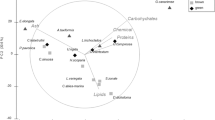Abstract
Polyphenols from two brown algae,Fucus vesiculosus (L.) andAscophyllum nodosum (L.) Le Jolis, inhibited feeding by the herbivorous snail,Littorina littorea. The active compounds were characterized as phloroglucinol polymers with a wide molecular weight range (mol wt <30,000 to >300,000) by spectroscopic, Ultrafiltration, thin-layer chromatographic, and chemical degradation data. As little as 1% (dry wt) polyphenol in food reduced feeding by more than 50%, and polyphenolic extracts inhibited feeding entirely when present in concentrations of 2–5% (dry wt). Commercially available phloroglucinol dihydrate and gallotannin, which are known herbivore feeding deterrents in terrestrial plants, inhibitedL. littorea feeding when added to food media in concentrations similar to those above. We conclude that polyphenols inF. vesiculosus andA. nodosum are functionally similar to terrestrial plant polyphenols (tannins) in providing chemical defenses against herbivores. This research is the first demonstration that chemical compounds defend these two dominant, perennial marine algae from the major herbivore found in their community.
Similar content being viewed by others
References
Al-Ogily, S.M., andKnight-Jones, E.W. 1977. Antifouling role of antibiotics produced by marine algae and bryozoans.Nature 265:728–729.
Conover, J.T., andSieburth, J.McN. 1964. Effect ofSargassum distribution on its epibiota and antibacterial activity.Bot. Mar. 6:147–157.
DeAlarcon, P.A., Donovan, M.E., Forbes, G.B., Landau, S.A., andStockman, J.A. 1979. Iron adsorption in the Thalasemia syndromes and its inhibition by tea.N. Engl. J. Med. 300:5–8.
Dement, W.A., andMooney, H.A. 1974. Seasonal variation in the production of tannins and cyanogenic glycosides in the chaparral shrub,Heteromeles arbutifolia.Oecologia 15:65–76.
Esping, U. 1957a. A factor inhibiting fertilization of sea urchin eggs from extracts of the algaFucus vesiculosus. I. The preparation of the factor inhibiting fertilization.Ark. Kemi 11:107–115.
Esping, U. 1957b. A factor inhibiting fertilization of sea urchin eggs from extracts of the algaFucus vesiculosus. II. The effect of the factor inhibiting fertilization on some enzymes.Ark. Kemi 11:117–127.
Feeny, P.P. 1970. Seasonal changes in oak leaf tannins and nutrients as a cause of spring feeding by winter moth caterpillars.Ecology 51:565–581.
Feeny, P.P. 1976. Plant apparency and chemical defense, pp. 1–40,in J. Wallace and R. Manseil (eds.). Recent Advances in Phytochemistry, Vol. 10. Biochemical Interaction between Plants and Insects. Plenum Press, New York.
Fritsch, F.E. 1945. The Structure and Reproduction of the Algae, Vol. II. Cambridge University Press, London.
Geiselman, J.A. 1978. Evidence for algal chemical defense against a marine herbivore. American Society of Limnology and Oceanography Annual Meeting, Abstracts, June 1978, Victoria, B.C.
Geiselman, J.A. 1980. Ecology of chemical defenses of algae against the herbivorous snail,Littorina littorea, in the New England rock intertidal community. PhD thesis. Massachusetts Institue of Technology/ Woods Hole Oceanographic Institution Joint Program. 209 PP.
Geiselman, J.A. 1981. In preparation.
Glombitza, K.W. 1977. Highly hydroxylated phenols of the Phaeophyceae, pp. 191–204,in D.J. Faulkner and W.H. Fenical (eds.). Marine Natural Products Chemistry. Plenum Press, New York.
Glombitza, K.W., Rosener, H.U., Vilter, H.,andRauwald, W. 1973. Antibiotica aus algen 8. mitt. phloroglucin aus Braunalgen.Planta Med. 24:301–303.
Glombitza, K.W., Rauwald, H.W., andEckhardt, G. 1975. Fucole, polyhydroxyoligophenyle ausFucus vesiculosus.Phytochemistry 14:1403–1405.
Hunger, F.W.T. 1902. Uber das Assimilations-Product der Dictyotaceen.Jahrb. Wiss. Bot. 38:70–82.
Levin, D.A. 1976. The chemical defenses of plants to pathogens and herbivores.Annu. Rev, Ecol. Syst. 7:121–159.
Levy, G.C., andNelson, G.L. 1972. Carbon-13 Nuclear Magnetic Resonance for Organic Chemists. Wiley-Interscience, New York.
Lubchenco, J. 1978. Plant species diversity in a marine intertidal community: Importance of herbivore food preference and algal competitive abilities.Am. Nat. 112:23–39.
McLachlan, J., andCraigie, J.S. 1966. Antialgal activity of some simple phenols.J. Phycol. 2:133–135.
Menge, J.L. 1975. Effect of herbivores on community structure of the New England rocky intertidal region: Distribution, abundance, and diversity of algae. PhD thesis. Harvard University, Cambridge, Massachusetts. 164 pp.
Miles, P.W. 1969. Interaction of plant phenols and salivary phenolases in the relationship between plants and Hemiptera.Entomol. Exp. App. 12:736–744.
Ragan, M.A. 1976. Physodes and the phenolic compounds of brown algae. Composition and significance of physodes in vivo.Bot. Mar. 19:145–154.
Ragan, M.A. 1978. Phenolic compounds in brown and red algae, pp. 157–179,in J.A. Hellebust and J.S. Craigie (eds.). Handbook of Phycological Methods, Vol. II. Cambridge University Press, Cambridge.
Ragan, M.A., andCraigie, J.S. 1976. Physodes and the phenolic compounds of brown algae. Isolation and characterization of phloroglucinol polymers fromFucus vesiculosus (L.).Can. J. Biochem. 54:66–73.
Ragan, M.A., Smidsrod, O., andLarsen, B. 1979. Chelation of divalent metal ions by brown algal polyphenols.Mar. Chem. 7:265–271.
Rhoades, D.F., andCates, R.G. 1976. Toward a general theory of plant antiherbivore chemistry. pp. 168–213,in J. Wallace and R. Mansell, (eds.). Recent Advances in Phytochemistry. Vol. 10. Biochemical Interaction between Plants and Insects. Plenum Press, New York.
Russell, G.B., Sutherland, O.R.W., Hutchins, R.F.N., andChristmas, P.E. 1978. Vesitol: A phytoalexin with insect feeding-deterrent activity.J. Chem. Ecol. 4:571–579.
Sieburth, J.McN, andConover, J.T. 1965.Sargassum tannin, an antibiotic which retards fouling.Nature 208:52–53.
Stahl, E. 1888. Pflanzen and Schnecken: Ein biologische Studie uber die Schutzmittel der Pflanzen gegen Schnecken Frass.Jena Z. Naturwiss Med. 15:557–684.
Todd, G.W., Getahun, A., andCress, D.C. 1971. Resistance in barley to the greenbug,Schizaphis graminum. I. Toxicity of phenolic and flavonoid compounds and related substances.Ann. Entomol. Soc. Am. 64:718–722.
van Sumere, C.F., Albrecht, J., Dedonder, A., de Footer, H., andPe, I. 1975. Plant proteins and phenolics, pp. 211–256,in J.B. Harborne and C.F. Van Sumere (eds.). The Chemistry and Biochemistry of Plant Proteins. Academic Press, New York.
Wehrli, F.W., andWirthlin, T. 1978. Interpretation of Carbon-13 NMR Spectra. Heyden, London.
Author information
Authors and Affiliations
Rights and permissions
About this article
Cite this article
Geiselman, J.A., McConnell, O.J. Polyphenols in brown algaeFucus vesiculosus andAscophyllum nodosum: Chemical defenses against the marine herbivorous snail,Littorina littorea . J Chem Ecol 7, 1115–1133 (1981). https://doi.org/10.1007/BF00987632
Received:
Revised:
Issue Date:
DOI: https://doi.org/10.1007/BF00987632




